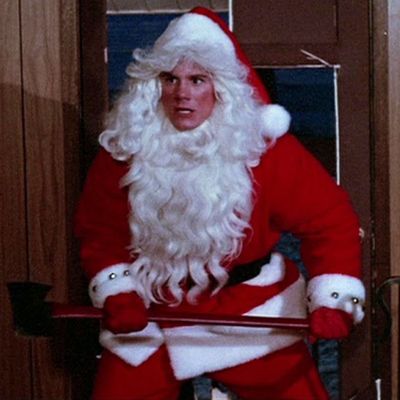
“You’ve made it through Halloween,” growled the narrator of the theatrical trailer and TV spot for the 1984 slasher picture Silent Night, Deadly Night. “Now try and survive Christmas.” The marketing was admirable in its transparency. Since the overwhelming financial success of John Carpenter’s 1978 classic, its “special occasion + knife-wielding killer” formula had been eagerly applied to numerous holidays and festivities: New Year’s Evil and Prom Night (1980); My Bloody Valentine, Final Exam, Bloody Birthday, Happy Birthday to Me, Hell Night, Graduation Day, and Home Sweet Home (1981); Tricks or Treats and Honeymoon Horror (1982); and, most of all, the Friday the 13th series, which began in 1980 with installments added, on an almost yearly basis, throughout the decade.
And it wasn’t that Silent Night, Deadly Night broke some sacred taboo. It wasn’t even the first Yuletide slasher movie. Horror fans had previously been gifted Silent Night, Bloody Night and the anthology film Tales From the Crypt (both 1972), Christmas Evil and To All a Goodnight (1980), The Dorm That Dripped Blood (1982), and most notably, Bob Clark’s 1974 Canadian film Black Christmas, which many have pinpointed as an unacknowledged inspiration for Halloween. Silent Night, Deadly Night wasn’t even the only Christmas horror movie of 1984; that December would see the U.S. and U.K. bows of the British Santa slasher Don’t Open ‘Till Christmas.
So why did none of those movies cause the uproar Silent Night, Deadly Night did? The answer, it seems, is the aforementioned TV spot, which juxtaposes images of holiday cheer and the beloved opening couplets of Clement Clarke Moore’s “Twas the Night Before Christmas” with the sight of a man in a Santa suit breaking down a door with an ax, pulling a gun, and making people scream:
The problem wasn’t that the ad was inaccurate — it is, in fact, quite true to the lurid nature of this scuzzy slasher, in which 8-year-old Billy witnesses the roadside murder of his parents by a deranged killer in a Santa suit, only to snap himself ten years later when his department-store job requires him to dress up as jolly ol’ Saint Nick. The problem was that someone in the marketing department at TriStar Pictures (which acquired the low-budget film from independent producer Ira Barmak) scheduled those TV spots on weekend, daytime hours — most prominently, during a Saturday afternoon Green Bay Packers football game.
“The response was quick,” Variety reported during the film’s November 1984 opening weekend. “Protests flooded Milwaukee radio and TV stations, most from a group calling itself Citizens Against Movie Madness, led by two local mothers.” The group organized an opening-day protest at the city’s Grand Theater; similar protests greeted the picture’s debut that week at the Interboro Quad Theater in the Bronx and the RKO Kingsway Theater in Coney Island. They carried signs with messages like “Deck the halls with holly, not bodies,” and “Santa’s not a hit man.” Denise Giordano, who organized the Brooklyn protest, told the New York Daily News, “The movie violates everything I believe in; it’s taking the spirit out of Christmas.” Bayport, Long Island, resident Dennis Colasunno told the paper he saw the TV commercial with his three young children, and “it scared the hell out of my kids — this commercial has ruined Christmas for my children.”
In response to the uproar, New York TV station WPIX moved the commercials to late-night slots, while stations in Albany and Boston pulled them altogether. The Boston Globe yanked the film’s newspaper ads, which featured the ax-wielding arm of a Santa on his way down the chimney. Yielding to protesters, the Bronx theater pulled the film after its first week, while two chains in Montana announced that they would not show the film when it moved west (it initially opened only in Midwest and Northeast markets).
But it’s often been said that there’s no such thing as bad publicity, and that adage was borne out by the opening weekend numbers: in less than 400 theaters, Silent Night, Deadly Night grossed a respectable $1.4 million. Unsurprisingly, Tri-Star announced that it would continue the film’s nationwide distribution, and would not alter its print ads. The distributor did acquiesce to protests by pulling the TV spots after the first week — but vice-president of Marketing Steve Randall told the New York Times, “We never planned to run the ads past the weekend, at least not until we saw how the picture did” — but pushed back against the commercial’s backlash, with Tri-Star VP David Rosenfeld sneering, “They didn’t complain about the commercials for Friday the 13th, which depicts 13 murders in the space of a minute.”
And then Siskel and Ebert got involved.
That the two best-known film critics in the country hated the movie — Gene Siskel deemed it, alongside the notorious I Spit on Your Grave, as “one of the two most contestable films I’ve ever seen” — was unsurprising. Slasher films were traditionally poorly reviewed (which rarely impacted the box office anyway), and Silent Night was no exception; Variety, one of the few outlets to bother reviewing it at all, deemed it “a nasty bit of business” that was “quite (unintentionally) hilarious.” But the duo didn’t just review Silent Night on their syndicated At the Movies program — they devoted an “X-Ray,” their in-depth commentary segment, to the movie, in which Siskel not only attacked the ads (“the showing of Santa with an axe on free TV in commercials is sick, and sleazy, and mean-spirited”) but called out the makers of the movie by name. “You people have nothing to be proud of, even if you made a few bucks off of all the negative publicity,” he announced, looking squarely into the camera. “Your profits truly are blood money.”
Even those name-checks might not have changed Silent Night’s fate — after all, these were obscure exploitation movie-makers, not movers and shakers. But Siskel also took pains to name the film’s high-profile distributor, twice: “Tri-Star Pictures, co-owned by Columbia Pictures, CBS, and Home Box Office. Shame on you.”
Suddenly, the company’s public pose shifted. “Tri-Star Pictures acknowledged some doubt as to whether Silent Night, Deadly Night … will reach the west coast,” Variety reported on November 21, following a second weekend in which grosses dropped 45 percent. “The decision on whether to open on the west coast or not will depend on whether we feel it’s commercially viable,” Rosenfeld told the trade publication, and days later, they made the call, withdrawing the film from release after only two weeks. The official line, per Variety, “is that the picture has been a box office disappointment,” but that hardly scans; its opening weekend gross was more than enough to cover its production budget, and its eighth place opening was two spots ahead of another new horror film, a little something titled A Nightmare on Elm Street. Sure, it dropped big in week two, but that’s hardly unique: the Jon Cryer comedy No Small Affair, which opened the same week, dropped 43 percent in week two.
The more plausible explanation is that Tri-Star (and likely its corporate ownership, which also included Coca-Cola) decided the picture wasn’t worth the trouble. “Negative pick-up” deals like this one had allowed respectable studios to reap the financial benefits of disreputable slasher movies for years; Universal acquired the Halloween franchise, Fox picked up Visiting Hours, and the Friday the 13th series, which Paramount acquired after a fierce bidding war with United Artists and Warner Brothers, was one of the studio’s primary profits sources of the 1980s — while keeping the product itself at arm’s length. But it was hard to do that when Gene Siskel was on television, talking about your “blood money.”
Tri-Star abandoned Silent Night before it even made it to the west coast, and spent weeks fighting producer Ira Barmak’s efforts to buy back domestic distribution rights to the picture. The parties finally made a deal, ironically enough, the week before Christmas of 1984; the new distributor, Aquarius Film Releasing, reissued the film to theaters (including out west) in May of 1985, with ads playing down Santa and playing up the controversy. But its heat had cooled.
When Silent Night, Deadly Night hit home video in 1986, it (predictably) finally found its audience — one that took not only to the film’s tawdry approach and unapologetic brutality, but the “forbidden fruit” air it had acquired over the previous two years. It spawned four sequels over five years, most released directly to video, and in 2012, a quasi-remake, titled simply Silent Night, was released to theaters. That film’s reception would’ve shocked both the 1984 version’s makers and its protesters: it came and went, with nary a peep, in about a week.




